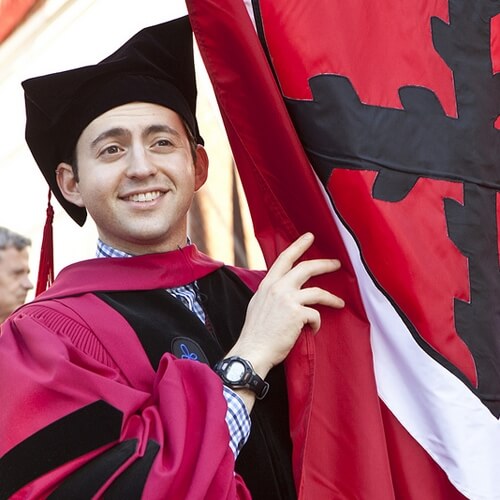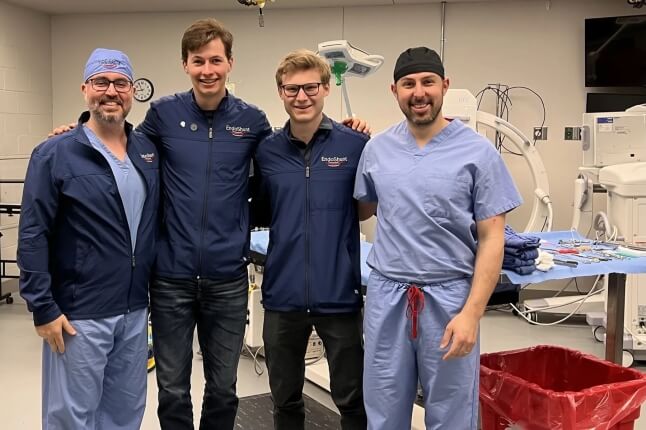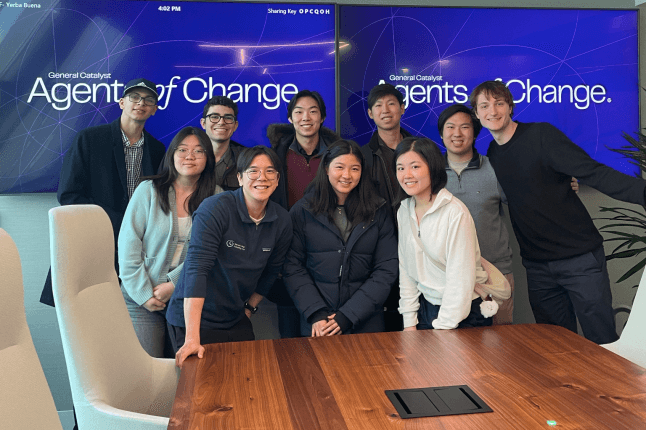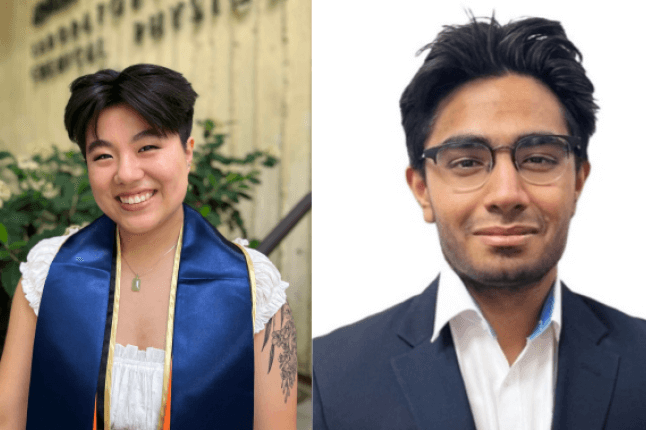News
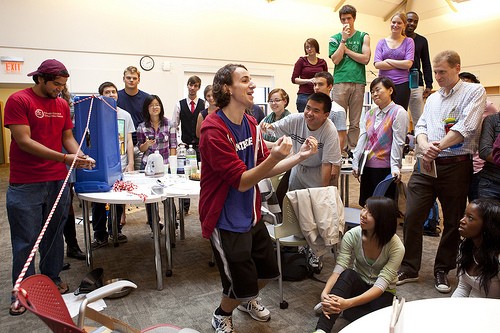
Undergraduates in AP 50, the introductory applied physics course taught by Prof. Eric Mazur, met in the Connaughton classroom to demonstrate their Rube Goldberg machines, which spanned the furniture and the walls. (Photo by Eliza Grinnell, SEAS Communications.)
June 2012
We hosted the Cambridge 8th Grade Science & Engineering Showcase as well as Step UP / Project TEACH, to share the excitement of science, engineering, and college life with young people in Cambridge and Boston.
We announced a new master's degree program in Computational Science & Engineering.
Atmospheric scientists led by Prof. Michael B. McElroy and the Harvard China Project released the first bottom-up estimates of China's carbon dioxide emissions—more independent, accurate, and rigorous than previous estimates.
Materials scientists led by Prof. Shriram Ramanathan created a hydrogen fuel cell that can store energy like a battery.
July 2012
Engineers led by Prof. Joanna Aizenberg created self-regulating nanomaterials that physically react to temperature, pH, pressure, or other tunable parameters. A slippery technology developed by Prof. Aizenberg's group was also shown to prevent more than 99% of harmful bacterial slime from forming on surfaces.
 Graduate student Moritz Bächer created a '3D print' button for animated characters.
Graduate student Moritz Bächer created a '3D print' button for animated characters.
Bioengineers led by Prof. Kevin Kit Parker created an artificial, swimming jellyfish out of heart cells from a rat, demonstrating the state of the art of tissue engineering.
Researchers at Harvard and the University of British Columbia, co-led by Prof. Scot Martin, showed that organic and inorganic materials in airborne particles can remain separate, in a double layer.
Prof. Greg Morrisett, undergraduate students, and collaborators developed a new tool that could increase security and enhance the performance of commonly used web and mobile applications.
Prof. Michael P. Brenner was named a Simons Investigator. Prof. Steven C. Wofsy received the American Geophysical Union's Roger Revelle Medal for his contributions to the understanding of Earth's climate systems.
Photo courtesy of Moritz Bächer.
August 2012
Captivated by a strange coiling behavior in the grasping tendrils of the cucumber plant, researchers led by Prof. L. Mahadevan characterized a new type of spring.
Engineers led by Prof. Donhee Ham demonstrated a drastically new way of achieving "extraordinarily strong" negative refraction in a metamaterial, more than a hundred times stronger than most previously reported.
Applied physicists led by Prof. Federico Capasso created a completely flat lens, made from an ultrathin wafer of silicon and gold, that focuses telecom wavelengths without distortion.
Geologist Prof. James R. Rice received the American Geophysical Union's Walter H. Bucher Medal for his “original contributions to the basic knowledge of the crust and lithosphere.”
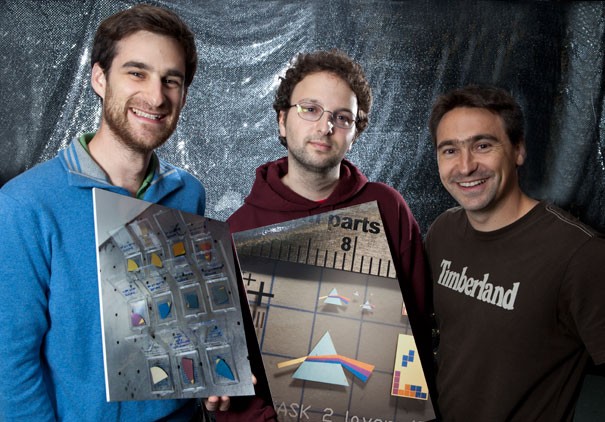
Applied physicists led by Prof. Federico Capasso created an ultrathin germanium coating that can appear in any color depending only on the number of atoms' thickness of the film. (Photo by Eliza Grinnell, SEAS Communications.)
September 2012
Bioengineers led by Prof. Sharad Ramanathan used precise lasers to manipulate neurons in worms’ brains, controlling their movement.
Computer scientists at SEAS, led by Prof. Salil Vadhan, received a nearly $5-million grant from the National Science Foundation to develop technologies and policies to protect the privacy of personal data used in research studies.
A team of experts in mechanics, materials science, and tissue engineering at Harvard created an extremely stretchy and tough gel that may pave the way to replacing damaged cartilage in human joints. The work was collaboratively led by Prof. Zhigang Suo, Prof. Joost J. Vlassak, and Prof. David J. Mooney.
A new investigation of tissues and signaling pathways in finches' beaks revealed surprising flexibility in the birds' evolutionary toolkit. Led by Prof. Arhat Abzhanov in the Department of Organismic and Evolutionary Biology at Harvard, the project also relied on researchers in applied mathematics at SEAS.
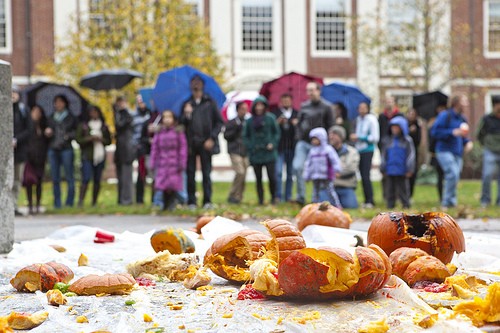
SEAS and the Department of Physics celebrated fall with the annual Pumpkin Drop, tossing Jello-filled gourds from the top floor of the Jefferson Laboratories. (Photo by Eliza Grinnell, SEAS Communications.)
October 2012
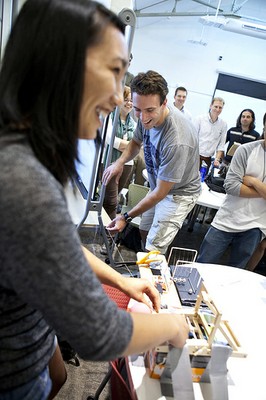 On October 1, 2012, we celebrated the 50th anniversary of ABET accreditation for our S.B. degree in engineering sciences.
On October 1, 2012, we celebrated the 50th anniversary of ABET accreditation for our S.B. degree in engineering sciences.
Undergraduates in AP 50, a brand-new introductory course in applied physics, built elaborate Rube Goldberg machines to illustrate the principles of energy and motion.
Researchers from NYU, Harvard, and Dow Chemical, including Prof. Vinothan Manoharan, created new microparticles that self-assemble like atoms into molecules.
Atmospheric research led by Prof. Scot Martin showed that when it comes to secondary organic material in the atmosphere, there are two distinct breeds: liquids and jellies. The findings may affect scientific models of cloud formation and light absorption.
Photo by Eliza Grinnell, SEAS Communications.
November 2012
Computational scientists and policy experts weighed in on voting theory, just in time for the November elections.
Bioengineers led by Prof. David Mooney created an injectable, gel-based sponge that delivers drugs, cells, and structure for medical applications.
Prof. Mike Aziz and colleagues at Harvard received a coveted ARPA-E grant to support research into next-generation flow batteries that will store solar and wind energy.
Climate expert Prof. Jim Anderson won the Smithsonian American Ingenuity Award, for helping to discover the link between climate change and ozone loss.
Prof. Joanna Aizenberg was elected a Fellow of the American Physical Society.
Prof. Jonathan Zittrain was named to Foreign Policy's Top 100 Global Thinkers for "staring down the Internet's enemies."
Aiden C. de B. Daly '13, a computer science concentrator, was named a Rhodes Scholar.
December 2012
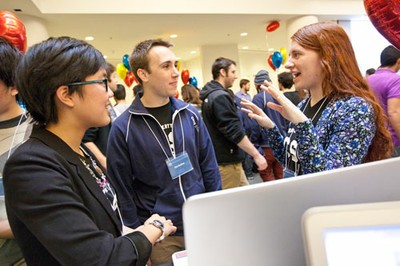 The Science & Cooking Fair highlighted undergraduates' unusual (and edible) science projects.
The Science & Cooking Fair highlighted undergraduates' unusual (and edible) science projects.
Hundreds of students showed off apps and more at the CS 50 Fair.
The SEAS Holiday Lecture, an annual tradition, delighted families with rainbows, flames, and an electrified pickle.
(Photo by Eliza Grinnell, SEAS Communications.)
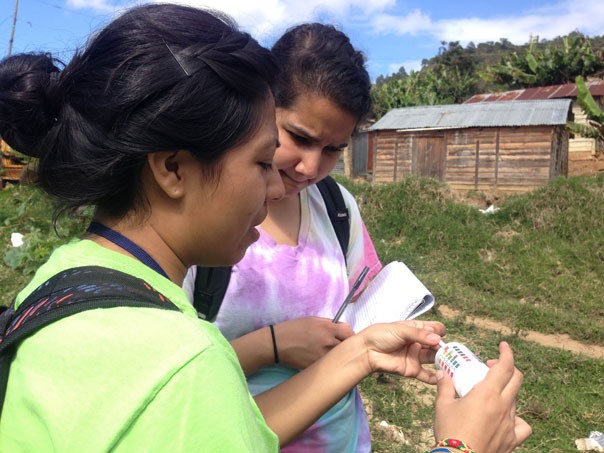
The Harvard chapter of Engineers Without Borders traveled to Pinalito, in the Dominican Republic, to help villagers assess their drinking water sources and find the best replacement for a broken well. (Photo by Casey Grun.)
January 2013
Teams of students from across Harvard mastered virtual foosball in the second annual IACS Computational Challenge. And ComputeFest brought experts and enthusiasts together for a weeklong celebration of computational science and engineering.
During the winter break, SEAS hosted hands-on workshops on design, prototyping, fabrication, welding, imaging, and much more.
Jennifer A. Lewis, a pioneer in microscale 3D printing and bioinspired materials, joined the Harvard faculty as Hansjörg Wyss Professor of Biologically Inspired Engineering.
Researchers led by Prof. Joanna Aizenberg created thin fibers that change color when stretched, taking inspiration from the skin of a tropical fruit.
Applied physicists led by Prof. Federico Capasso invented a new device that can count the twists in a helical light beam.
Prof. Leslie Valiant was named a 2012 Fellow of the Association for Computing Machinery for his "transformative contributions to the theory of computation."
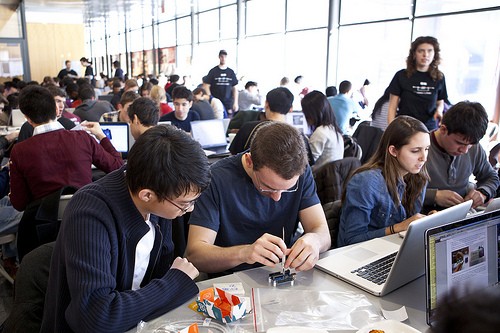
Undergraduates in ES 50, our introductory course in electrical engineering, filled the Maxwell Dworkin lobby for a lesson on Arduino electronics controllers. Enrollment in ES 50 reached 164 this year, a huge jump from 73 last spring. (Photo by Eliza Grinnell, SEAS Communications.)
February 2013
Prof. Steven C. Wofsy and other experts in atmospheric science released the data set from the HIPPO research flights for public use. Data from the 64 flights offer insight into the global carbon cycle and aerosols for climate modeling.
Research led by Prof. David Keith suggested that the real-world generating capacity of wind farms at large scales has been overestimated.
Sujata Bhatia and Prof. David Parkes received the McDonald Award for their dedication to mentoring and advising. Krzysztof Gajos, Assistant Professor of Computer Science, was named a 2013 Alfred P. Sloan Research Fellow.
David Cox, who teaches machines to see, was appointed Assistant Professor of Computer Science at SEAS in addition to his role as Assistant Professor of Molecular and Cellular Biology at Harvard.
March 2013
A cutting-edge museum exhibit called Life on Earth, designed at SEAS to teach the principles of evolution to the public, opened at the Harvard Museum of Natural History. The project, led by computer scientist Chia Shen, allows museum visitors to zoom and scroll through the Tree of Life, the immense tree diagram that shows the evolutionary history of millions of related species.
Harvard and BASF announced a renewed research initiative that will focus on developing innovative materials for the automotive, building and construction, and energy sectors.
Experts at Harvard and UCLA, led by Prof. David Keith, proposed a new structure for the regulation of geoengineering research.
April 2013
The Harvard College Innovation (I3) Challenge awarded grants and support to students' entrepreneurial projects.
“Our students don’t sit back,” said Paul Bottino, Executive Director of the Technology and Entrepreneurship Center at SEAS. “When they see a need in health care, in government, or in everyday life, they also see tremendous innovative solutions. But more importantly, they believe in their own ability to make change."
Physicists led by Prof. Federico Capasso created a nanoscale router that converts and directs optical signals efficiently.
Graduate students in Prof. Rob Howe's group created an inexpensive tactile sensor, putting touch within the grasp of robotic hands.
Pedagogical innovator Prof. Eric Mazur sold his spin-off company, Learning Catalytics, to Pearson.
Prof. David J. Mooney received the Everett Mendelsohn Excellence in Mentoring Award from the Harvard Graduate Student Council.
Researchers in Prof. Joanna Aizenberg's group showed how E. coli use their flagella like biological grappling hooks to cling to the crevices in rough surfaces. Their findings help explain how harmful biofilms grow.
Vinothan N. Manoharan, an expert in the study of self-assembly, was promoted to full professor with tenure.
Prof. Federico Capasso was selected to receive the SPIE Gold Medal, a recognition of his exceptional contributions to optics and photonics.
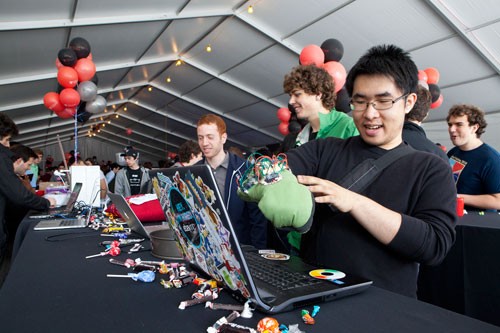
Part classroom, part carnival, the SEAS Design & Project Fair showcased the diversity of creative projects coming out of our courses—including, for example, a mathematical system for crowdsourcing stock picks; an automatic fish feeder; a one-wheeled, self-balancing electric vehicle; a secret-knock-detecting door; and a mind-controlled car. (Photo by Eliza Grinnell, SEAS Communications.)
May 2013
In the culmination of a decade's work, robotic flying insects developed in Prof. Rob Wood's lab achieved vertical takeoff, hovering, and steering.
Materials scientists in Prof. Joanna Aizenberg's group discovered a way to sculpt self-assembling crystals into a range of tiny forms. They demonstrated their methods by creating fields of micron-scale blossoms and flowers on a glass slide.
Prof. John Hutchinson was elected to the Royal Society; Prof. Federico Capasso received the European Physical Society Prize; and Prof. Salil Vadhan was named a Simons Investigator.
Nucleik, a crime-fighting start-up created by three computer science undergraduates, Scott Crouch, Matthew Polega, and Florian Mayr, won the grand prize in the Harvard President's Challenge for social entrepreneurship. Their project built on work they started in a junior design course at SEAS.
Topics: Events, Environment, Electrical Engineering, Computer Science, Bioengineering, Applied Physics, Applied Mathematics
Cutting-edge science delivered direct to your inbox.
Join the Harvard SEAS mailing list.
